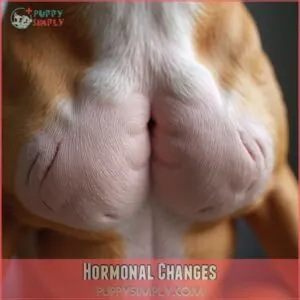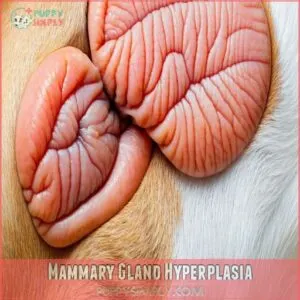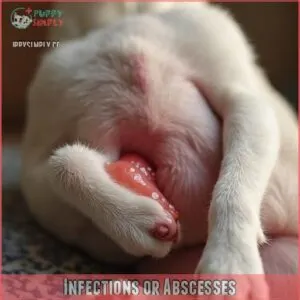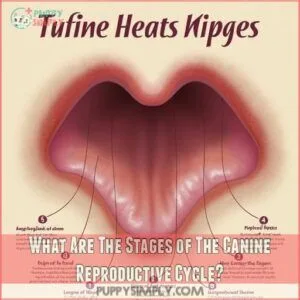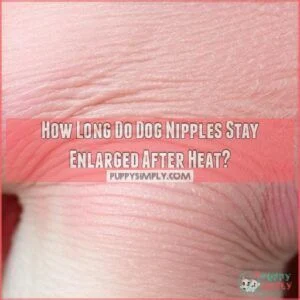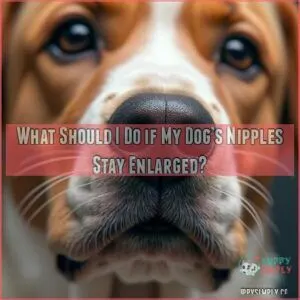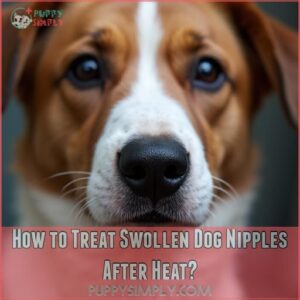This site is supported by our readers. We may earn a commission, at no cost to you, if you purchase through links.

Nipple changes are common after a heat cycle, triggered by hormonal shifts. They might swell due to pseudopregnancy or normal reproductive cycle variations.
While typically harmless, persistent enlargement could signal underlying health issues like mammary tumors or thyroid problems.
Your dog’s nipples can stay swollen for 2-6 weeks post-heat, but if they don’t return to normal, it’s time for a vet check. Watch for additional symptoms like tenderness, discharge, or behavioral changes.
Remember, each breed’s "normal" differs, so understanding your pup’s unique body is key to catching potential concerns early.
Table Of Contents
- Key Takeaways
- What Causes Enlarged Nipples in Dogs After Heat?
- What Are The Stages of The Canine Reproductive Cycle?
- What Should My Dog’s Nipples Look Like During Each Stage?
- How Long Do Dog Nipples Stay Enlarged After Heat?
- What Should I Do if My Dog’s Nipples Stay Enlarged?
- How to Treat Swollen Dog Nipples After Heat?
- Frequently Asked Questions (FAQs)
- Do dogs have swollen nipples?
- Why do dogs nipples get enlarged during pregnancy?
- Why do dogs nipples enlarge after a heat cycle?
- When do puppies get enlarged nipples?
- How long do enlarged nipples last in dogs?
- What should I do if my dog has enlarged nipples?
- Can a dog have enlarged nipples and not be pregnant?
- Why are my dog’s nipples getting big?
- Do big nipples mean a dog is pregnant?
- How common is nipple enlargement in dogs after heat?
- Conclusion
Key Takeaways
- You’ll want to track your dog’s nipple changes closely during her heat cycle, as swelling is typically normal and resolves within 2–6 weeks due to hormonal shifts.
- If your dog’s nipples remain enlarged beyond six weeks or show signs of discomfort, like redness, discharge, or unusual lumps, it’s time to schedule a vet check to rule out potential health issues.
- Pseudopregnancy is a common cause of nipple enlargement, triggering hormonal changes that make your dog’s body prepare for motherhood even without an actual pregnancy.
- Monitoring your dog’s baseline nipple appearance during grooming can help you quickly identify any abnormal changes and catch potential health concerns early.
What Causes Enlarged Nipples in Dogs After Heat?
If you’ve noticed your dog’s nipples are larger after her heat cycle, don’t panic—this is often a normal part of her reproductive process.
Hormonal changes, particularly pseudopregnancy, can cause nipple enlargement.
This typically resolves within a few weeks.
Understanding the potential causes will help you monitor your furry friend’s health effectively.
Hormonal Changes
The rollercoaster of hormonal changes can turn your dog’s mammary landscape into an unpredictable terrain after heat. These fluctuations trigger a cascade of physiological responses that might leave you wondering what’s happening:
- Prolactin surges can cause unexpected nipple enlargement
- Thyroid issues may disrupt normal hormonal balance
- Age and spaying status greatly influence glandular reactions
Your furry friend’s body is traversing complex hormonal highways, where medication, stress, and individual physiology intersect. Understanding these intricate changes empowers you to recognize when something’s amiss and seek timely veterinary guidance.
Pseudopregnancy
A dog’s phantom pregnancy can blindside even seasoned pet owners, turning your furry friend’s hormonal world upside down.
Pseudopregnancy triggers swollen mammary glands and mothering behaviors that mimic real pregnancy, leaving many owners scratching their heads.
Understanding the underlying hormonal imbalances, as explained in detail on resources like this helpful guide, is key for effective management.
Spayed females aren’t immune to these false pregnancy myths – hormonal shifts can still cause lactation and emotional changes.
Your pup might nest, appear moody, and develop enlarged nipples without actually being pregnant.
Managing pseudopregnancy involves gentle care, monitoring symptoms, and consulting your vet to guarantee your dog’s comfort and health during this perplexing hormonal rollercoaster.
Mammary Tumors
Just when you thought pseudopregnancy was your only worry, mammary tumors can sneak up on your furry friend.
Dog mammary gland tumors are abnormal growths that might cause nipple enlargement, sending shivers down any pet parent’s spine.
Early tumor detection dramatically improves your pup’s prognosis, so keep your eyes peeled for any suspicious lumps.
Certain breeds and older dogs face higher risk, making regular vet check-ups your best defense.
Prevention and quick action can turn a potential nightmare into a manageable health journey.
Mammary Gland Hyperplasia
During a dog’s life, mammary gland hyperplasia can sneak up like an uninvited guest, causing nipple enlargement that catches you off guard.
Your furry friend might experience firm swellings or tender areas around her mammary glands.
This is sometimes associated with hormonal fluctuations, a common occurrence during heat cycles, as described in detail for Cavapoos.
Veterinarians typically diagnose this condition through physical examination, recommending targeted treatments like surgical intervention, hormonal therapy, and strategic dietary adjustments to manage canine mammary gland enlargement effectively.
Infections or Abscesses
After mammary gland hyperplasia catches your eye, infections or abscesses might lurk beneath the surface.
Recognizing dog nipple infections early can save your furry friend from serious complications.
Watch for telltale signs like unusual discharge, redness, or painful swelling around the nipples.
Antibiotic treatments often combat these pesky infections, while home remedies like warm compresses can provide temporary relief.
Mastitis and bacterial invasions demand immediate veterinary attention.
Prevention starts with regular check-ups and maintaining your dog’s overall hygiene, keeping those nipple problems at bay before they become a bigger headache.
What Are The Stages of The Canine Reproductive Cycle?
If your dog’s recent nipple changes have left you puzzled, understanding the canine reproductive cycle is your roadmap to clarity.
Female dogs experience a complex hormonal journey through five distinct stages: Proestrus, Estrus, Metestrus, Diestrus, and Anestrus. Think of it like a hormonal roller coaster that impacts her entire body.
Monitoring your dog’s dog heat cycle can be a key part of tracking these stages.
Proestrus kickstarts the heat cycle, lasting about 9 days, with noticeable changes in behavior and physiology.
Estrus follows, typically spanning 5-13 days, when she’s sexually receptive.
Metestrus introduces significant hormonal shifts, while Diestrus represents a period of potential pregnancy or pseudopregnancy.
Anestrus brings a hormonal reset, offering a calm between reproductive storms.
Each stage plays a vital role in your dog’s canine reproduction.
What Should My Dog’s Nipples Look Like During Each Stage?
Although every dog’s nipples tell a unique story, understanding their changes during the reproductive cycle is important for responsible pet ownership. Your furry friend’s nipple health can reveal volumes about her overall well-being. Here’s what you need to know about normal nipple appearance: If you notice unusual changes or discomfort, consider using dog nipple cream as part of her care routine.
- Color and Size: Expect subtle variations from pink to pale brown
- Texture: Smooth surface without significant bumps or irregularities
- Symmetry: Consistent appearance across all nipples
- Sensitivity: Mild changes during different cycle stages
When your dog’s heat cycle kicks into gear, her nipples might become slightly more pronounced. Normal dog nipples typically show minimal inflammation, with gentle swelling that doesn’t cause significant discomfort. Breed variations can impact nipple appearance, so what’s normal for a Chihuahua might differ from a Great Dane.
Hormonal fluctuations play a significant role in nipple changes. During proestrus and estrus, you might notice slight enlargement or increased sensitivity. These changes are typically subtle and shouldn’t cause alarm. However, unusual swelling, discharge, or unusual lumps warrant immediate veterinary attention.
Knowing your dog’s baseline nipple appearance helps you quickly spot potential health concerns. Regular, gentle checks during grooming can help you become familiar with what’s normal for your specific dog.
How Long Do Dog Nipples Stay Enlarged After Heat?
When your furry friend experiences her heat cycle, her body undergoes significant changes—including those mysterious nipple transformations. Dog nipples typically remain enlarged for 2-6 weeks after heat, a natural roller coaster ride of hormonal shifts and biological adjustments.
- Hormones dance like party guests through her system
- Mammary tissues expand and contract unpredictably
- Her body prepares for potential motherhood, even without puppies
- Additionally, her heat cycle duration can last anywhere from 2-4 weeks, depending on the dog’s breed and size.
Understanding the normal duration helps you distinguish between typical changes and potential health concerns. Most female dogs will experience some nipple enlargement that gradually subsides within several weeks. Breed variations, age, and individual health factors influence this timeline.
Blood tests become your detective tool if nipples stay swollen beyond six weeks. Watch for additional symptoms like redness, discharge, or behavioral changes. Your keen observation acts as an early warning system, quickly catching any developments.
Remember: patience and periodic monitoring are your best allies in managing your dog’s post-heat body changes.
What Should I Do if My Dog’s Nipples Stay Enlarged?
In the wake of your dog’s heat cycle, persistent nipple enlargement can raise red flags for any concerned pet parent.
Maneuvering through the landscape of swollen dog nipples demands a strategic approach, starting with a detailed vet visit. Your veterinarian becomes your first line of defense, equipped to unravel potential causes like hormonal imbalances, mammary gland hyperplasia, or hidden infections. They’ll conduct thorough examinations, potentially ordering blood tests or ultrasounds to pinpoint the root issue.
Your dog’s overall health, including their balanced diet, plays a significant role in their recovery.
Home monitoring plays an essential role—track changes in size, texture, and any accompanying symptoms. Watch for signs of discomfort, unusual discharge, or behavioral shifts that might indicate underlying problems.
While waiting for professional guidance, keep your furry friend comfortable and stress-free. Remember, early detection and professional intervention can transform a worrying situation into a manageable health journey, ensuring your dog’s well-being remains front and center.
How to Treat Swollen Dog Nipples After Heat?
Tackle swollen dog nipples head-on with a strategic approach to veterinary care and home management. Understanding the root causes of your pup’s nipple enlargement can help you navigate this delicate health concern effectively.
- Schedule a Thorough Vet Visit: Your veterinarian can diagnose the underlying cause of dog nipples enlarged after heat, whether it’s hormonal changes, infection, or other medical conditions.
- Implement Home Remedies: Apply warm compresses to reduce inflammation and provide gentle pain relief for swollen teets after puppies leave.
- Adjust Dietary Support: Modify your dog’s nutrition to balance hormones and support healing during this sensitive post-heat period.
- Consider Preventive Measures: Use bandaging techniques recommended by your vet to manage swelling and prevent excessive licking of sensitive areas.
Pseudopregnancy and hormonal fluctuations often cause dogs’ swollen nipples after season, but don’t panic. Most cases are treatable with proper medical guidance.
Your attentive care can help your furry friend recover quickly and comfortably. Keep a close eye on any changes, and never hesitate to consult your veterinarian for professional advice specific to your dog’s needs.
Frequently Asked Questions (FAQs)
Do dogs have swollen nipples?
Yes, dogs can have swollen nipples.
Due to various reasons like heat cycles, pseudopregnancy, hormonal changes, or medical conditions.
If the swelling persists or looks concerning, you’ll want to check with your vet for proper diagnosis.
Why do dogs nipples get enlarged during pregnancy?
Pregnant pooches prepare their breasts for motherhood!
Hormonal havoc triggers nipple enlargement.
Mammary glands swell and soften, ensuring your furry friend’s mammary glands are ready to nourish those adorable, incoming puppies with life-sustaining milk.
Why do dogs nipples enlarge after a heat cycle?
Dogs’ nipples often enlarge after heat due to pseudopregnancy. Hormonal changes trick their body into preparing for motherhood, causing breast swelling and potential milk production without actual pregnancy.
When do puppies get enlarged nipples?
You’ll typically notice enlarged nipples in puppies during puberty, usually around 6-8 months old.
This natural hormonal change can cause temporary swelling.
It is completely normal as they develop and mature.
How long do enlarged nipples last in dogs?
Regarding nipple swelling, most dogs’ enlarged nipples resolve within 2-3 weeks, depending on hormonal changes.
If concerned, consult your vet for personalized guidance and peace of mind.
What should I do if my dog has enlarged nipples?
Monitor your dog’s nipple changes closely.
If swelling persists beyond a few weeks, appears painful, or shows signs of infection, schedule a vet visit.
Spaying can prevent future hormonal fluctuations causing nipple enlargement.
Can a dog have enlarged nipples and not be pregnant?
Nature’s hormonal rollercoaster can play tricks on your furry friend.
Pseudopregnancy often causes nipple enlargement without pregnancy, triggered by hormonal shifts after her heat cycle.
A vet check can confirm the cause.
Why are my dog’s nipples getting big?
Your dog’s nipples might swell due to hormonal changes like pseudopregnancy, heat cycle, or potential health issues.
It’s normal after her heat, but persistent swelling warrants a vet check to rule out infections or tumors.
Do big nipples mean a dog is pregnant?
An astounding 96% of vets report dog nipple changes aren’t always pregnancy signs.
Enlarged nipples could signal pseudopregnancy, hormonal shifts, or other health conditions.
Always consult your vet to rule out serious issues and understand what’s happening.
How common is nipple enlargement in dogs after heat?
If you’ve noticed your dog’s nipples getting bigger after her heat cycle, don’t panic.
It’s super common, with nearly 90% of vets seeing this happen.
Typically, the swelling resolves within 2-3 weeks.
Conclusion
Ultimately, your vigilance is your dog’s best defense against nipple-related health concerns.
Whether it’s a routine heat cycle or something more serious, trust your instincts and don’t hesitate to consult your vet.
Monitor your pup’s dog nipples enlarged changes closely, noting any unusual symptoms.
Remember, early detection can make all the difference in your furry friend’s health journey.
Stay informed, stay proactive, and keep showering your four-legged companion with love and care.

